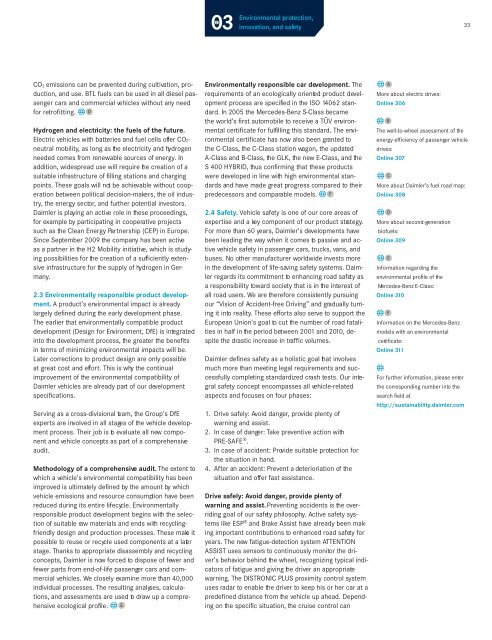Daimler Sustainability Report 2010 - Daimler Sustainability Report ...
Daimler Sustainability Report 2010 - Daimler Sustainability Report ...
Daimler Sustainability Report 2010 - Daimler Sustainability Report ...
You also want an ePaper? Increase the reach of your titles
YUMPU automatically turns print PDFs into web optimized ePapers that Google loves.
CO2 emissions can be prevented during cultivation, production,<br />
and use. BTL fuels can be used in all diesel passenger<br />
cars and commercial vehicles without any need<br />
for retrofitting. q D<br />
Hydrogen and electricity: the fuels of the future.<br />
Electric vehicles with batteries and fuel cells offer CO2neutral<br />
mobility, as long as the electricity and hydrogen<br />
needed comes from renewable sources of energy. In<br />
addition, widespread use will require the creation of a<br />
suitable infrastructure of filling stations and charging<br />
points. These goals will not be achievable without cooperation<br />
between political decision-makers, the oil industry,<br />
the energy sector, and further potential investors.<br />
<strong>Daimler</strong> is playing an active role in these proceedings,<br />
for example by participating in cooperative projects<br />
such as the Clean Energy Partnership (CEP) in Europe.<br />
Since September 2009 the company has been active<br />
as a partner in the H2 Mobility initiative, which is studying<br />
possibilities for the creation of a sufficiently extensive<br />
infrastructure for the supply of hydrogen in Germany.<br />
2.3 Environmentally responsible product development.<br />
A product’s environmental impact is already<br />
largely defined during the early development phase.<br />
The earlier that environmentally compatible product<br />
development (Design for Environment, DfE) is integrated<br />
into the development process, the greater the benefits<br />
in terms of minimizing environmental impacts will be.<br />
Later corrections to product design are only possible<br />
at great cost and effort. This is why the continual<br />
improvement of the environmental compatibility of<br />
<strong>Daimler</strong> vehicles are already part of our development<br />
specifications.<br />
Serving as a cross-divisional team, the Group’s DfE<br />
experts are involved in all stages of the vehicle development<br />
process. Their job is to evaluate all new component<br />
and vehicle concepts as part of a comprehensive<br />
audit.<br />
Methodology of a comprehensive audit. The extent to<br />
which a vehicle’s environmental compatibility has been<br />
improved is ultimately defined by the amount by which<br />
vehicle emissions and resource consumption have been<br />
reduced during its entire lifecycle. Environmentally<br />
responsible product development begins with the selection<br />
of suitable raw materials and ends with recyclingfriendly<br />
design and production processes. These make it<br />
possible to reuse or recycle used components at a later<br />
stage. Thanks to appropriate disassembly and recycling<br />
concepts, <strong>Daimler</strong> is now forced to dispose of fewer and<br />
fewer parts from end-of-life passenger cars and commercial<br />
vehicles. We closely examine more than 40,000<br />
individual processes. The resulting analyses, calculations,<br />
and assessments are used to draw up a comprehensive<br />
ecological profile. q E<br />
Environmental protection,<br />
innovation, and safety<br />
Environmentally responsible car development. The<br />
requirements of an ecologically oriented product development<br />
process are specified in the ISO 14062 standard.<br />
In 2005 the Mercedes-Benz S-Class became<br />
the world’s first automobile to receive a TÜV environmental<br />
certificate for fulfilling this standard. The environmental<br />
certificate has now also been granted to<br />
the C-Class, the C-Class station wagon, the updated<br />
A-Class and B-Class, the GLK, the new E-Class, and the<br />
S 400 HYBRID, thus confirming that these products<br />
were developed in line with high environmental standards<br />
and have made great progress compared to their<br />
predecessors and comparable models. q F<br />
2.4 Safety. Vehicle safety is one of our core areas of<br />
expertise and a key component of our product strategy.<br />
For more than 60 years, <strong>Daimler</strong>’s developments have<br />
been leading the way when it comes to passive and active<br />
vehicle safety in passenger cars, trucks, vans, and<br />
buses. No other manufacturer worldwide invests more<br />
in the development of life-saving safety systems. <strong>Daimler</strong><br />
regards its commitment to enhancing road safety as<br />
a responsibility toward society that is in the interest of<br />
all road users. We are therefore consistently pursuing<br />
our “Vision of Accident-free Driving” and gradually turning<br />
it into reality. These efforts also serve to support the<br />
European Union’s goal to cut the number of road fatalities<br />
in half in the period between 2001 and <strong>2010</strong>, despite<br />
the drastic increase in traffic volumes.<br />
<strong>Daimler</strong> defines safety as a holistic goal that involves<br />
much more than meeting legal requirements and successfully<br />
completing standardized crash tests. Our integral<br />
safety concept encompasses all vehicle-related<br />
aspects and focuses on four phases:<br />
1. Drive safely: Avoid danger, provide plenty of<br />
warning and assist.<br />
2. In case of danger: Take preventive action with<br />
PRE-SAFE ® .<br />
3. In case of accident: Provide suitable protection for<br />
the situation in hand.<br />
4. After an accident: Prevent a deterioriation of the<br />
situation and offer fast assistance.<br />
Drive safely: Avoid danger, provide plenty of<br />
warning and assist.Preventing accidents is the overriding<br />
goal of our safety philosophy. Active safety systems<br />
like ESP ® and Brake Assist have already been making<br />
important contributions to enhanced road safety for<br />
years. The new fatigue-detection system ATTENTION<br />
ASSIST uses sensors to continuously monitor the driver’s<br />
behavior behind the wheel, recognizing typical indicators<br />
of fatigue and giving the driver an appropriate<br />
warning. The DISTRONIC PLUS proximity control system<br />
uses radar to enable the driver to keep his or her car at a<br />
predefined distance from the vehicle up ahead. Depending<br />
on the specific situation, the cruise control can<br />
q<br />
More about electric drives:<br />
Online 306<br />
33<br />
q B<br />
The well-to-wheel assessment of the<br />
energy efficiency of passenger vehicle<br />
drives:<br />
Online 307<br />
q<br />
C<br />
More about <strong>Daimler</strong>’s fuel road map:<br />
Online 308<br />
q<br />
D<br />
More about second-generation<br />
biofuels:<br />
Online 309<br />
q<br />
A<br />
E<br />
Information regarding the<br />
environmental profile of the<br />
Mercedes-Benz E-Class:<br />
Online 310<br />
q F<br />
Information on the Mercedes-Benz<br />
models with an environmental<br />
certificate:<br />
Online 311<br />
q<br />
For further information, please enter<br />
the corresponding number into the<br />
search field at<br />
http://sustainability.daimler.com



